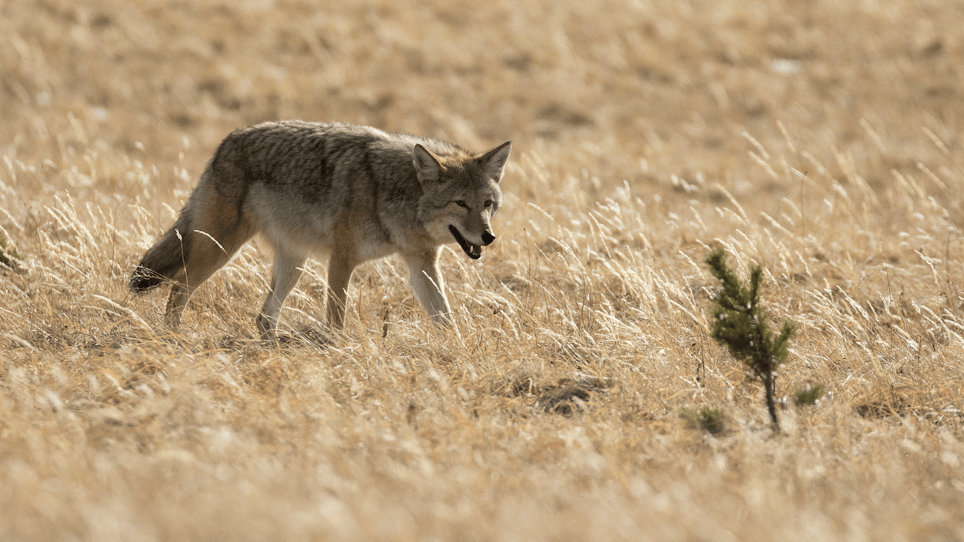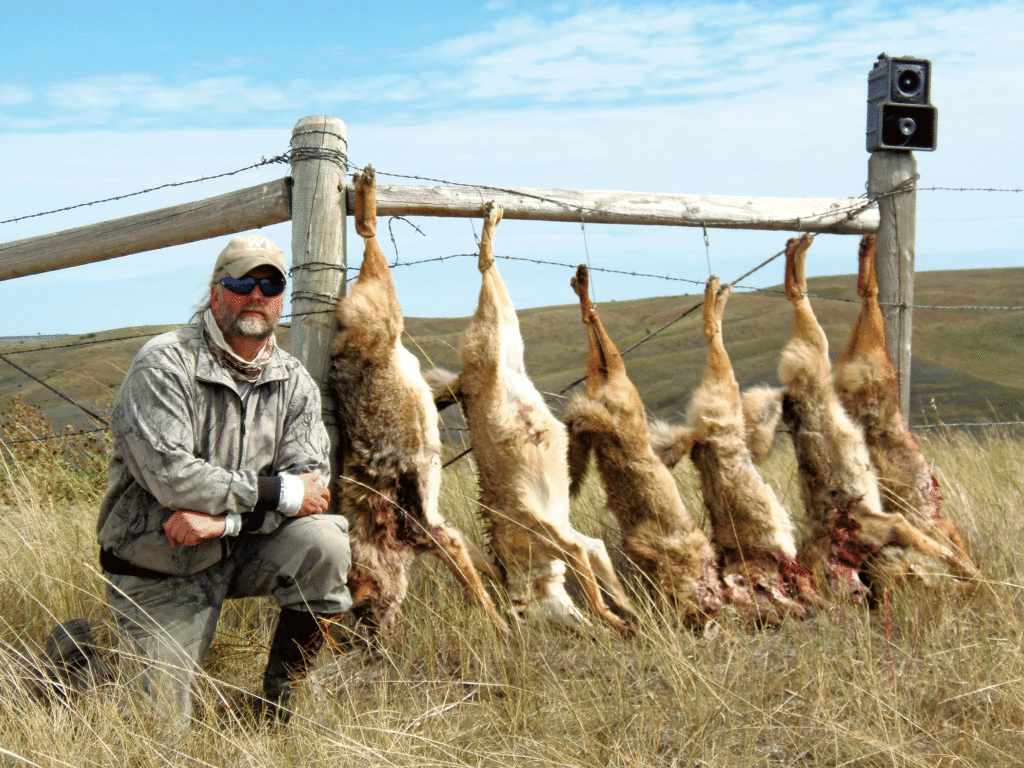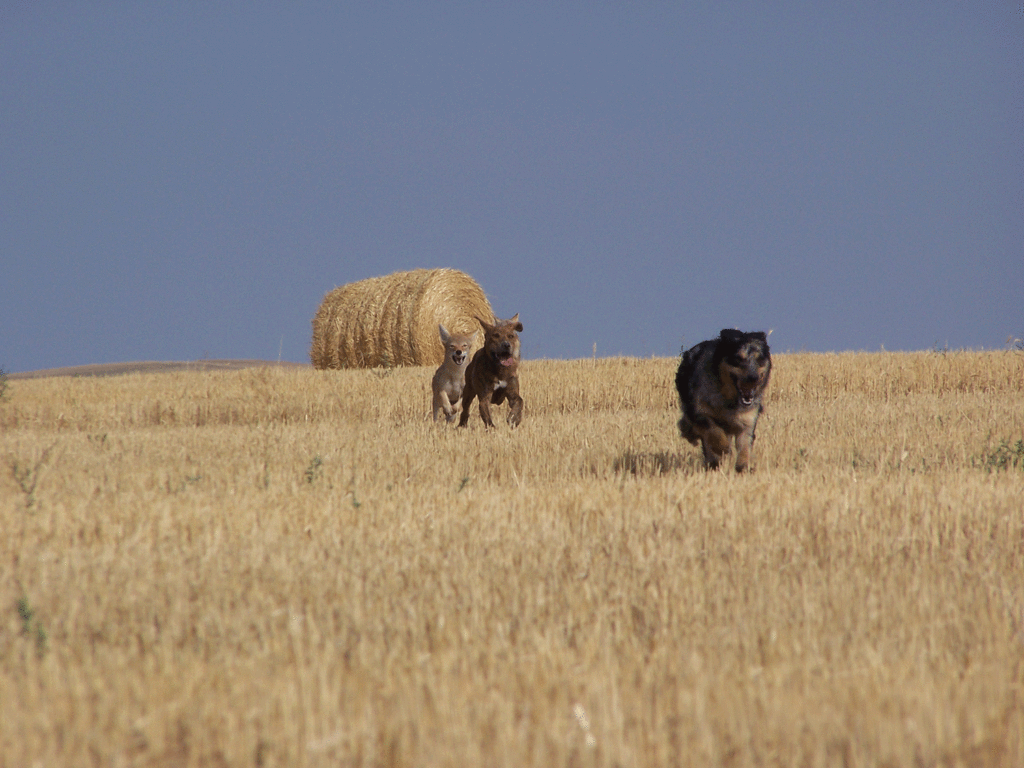
According to veteran predator hunter Randy Roede, more times that not it's curiosity that brings coyotes within range for a shot. (Photo: Moose Henderson)
Would you like to hunt coyotes like a pro? Would you like to understand what sets a professional predator hunter apart from the nimrod masses?
Randy Roede lives what many consider “the dream.” Roede has spent the past 40-plus years hunting predators. He’s lived the dream of hunting predators professionally for more than a decade as a wildlife damage specialist for the South Dakota Game, Fish and Parks.
It’s a profession where riches oftentimes come in forms other than Franklins. You have to consider the fact you get to work outdoors instead of an office and on occasion bring a smile to a rancher after showing them a pile of fur in the back of a truck bed. Roede also isn’t reserved when it comes to helping others take more coyotes. A dead coyote isn’t an educated coyote with another classroom experience in avoiding the working end of a rifle. He’ll never brag about being a professional predator hunter, but his story illuminates the difference between him and the typical predator hunting crowd.
How To Go Pro
Roede started his hunting roots humbly in the northwest corner of Iowa farm country. His father likely set the stage for Roede’s predator passion. Even before Roede was born his father ran greyhounds, whippets and mixed-breed hounds for fox — and the rare coyote. This took place in the 1950s and 60s, and his father’s hunting group even utilized an airplane to coordinate the chase.
“They had a Piper Cub that would be used to locate the fox,” Roede said. “Then, they’d either cut the engine and yell at my dad with the information, or toss a can with a note in it out of the window of the airplane. The dogs rode in an old Desoto car and travel was limited to the main roads when there was snow on the ground.”
Roede wishes he had been around to enjoy just one chase with his father and the dogs, but tragically his father was killed in an auto accident when he was 10 years old. Armed with a BB gun, Roede continued to sharpen his young shooting skills. He begged everyone he could to take him hunting or fishing. Fortunately, a thoughtful brother-in-law, Ken Duis, took him out whenever possible. It was Duis who introduced him to the art of spot-and-stalk fox hunting; an activity that fed his predator hunger.
The 1970s rolled around and Roede jumped into trapping. Raccoons, muskrat and mink were the main targets. But once everything froze up he returned to his true love: fox hunting.
In the 1980s, Roede started using snares, and his catch increased exponentially. By the 1990s, coyotes were denning in his Iowa territory, giving him another fur prize to pursue. Coyotes were hunted relentlessly in the Iowa farm country and few dumb coyotes survived after the ground turned white due to the intense hunting pressure.
“They learned to hide well in the open country,” recalls Roede. “At first light they would head to culverts, holes, sloughs and other cover to seek refuge from man.”

Randy Roede in his 40-plus years of professionally hunting coyotes has learned what separates the professionals from amateurs. Fortunately, he's willing to tell the amateurs what they do differently to be more effective.
For Roede, the real break in coyote success came with the purchase of his first howler and getting coyotes to answer under the cover of darkness. The light bulb lit up, and Roede discovered that knowing where coyotes were just before sunrise gave him a huge advantage over others trying to call coyotes. He was so successful that even the truck-hunting crowd viewed him as a threat to their weekend-warrior fun. It was also in this time period when Roede acquired his first decoy dog, a greyhound/German shorthair cross.
“She took to it immediately, a natural decoy dog if there ever was one. Today I always have a decoy dog at the ready, especially when I’m dealing with problem coyotes in the spring and summer. It’s an effective way to target specific coyotes with guaranteed results,” says Roede.
Professional Perspective
Roede breaks coyote callers into three different groups. First, he views a large part of the crowd as recreational callers just out for fun. They want to kill a coyote but do little in preparation, scouting and honing shooting skills to succeed. It’s just not a serious endeavor.
The second group he classifies is the contest caller who looks at killing coyotes for monetary gain. They have a plan for all day, enough land to hunt all weekend and setups to cover any wind direction. They are serious and have “a backup plan for their backup plan.”
The third group is the animal damage-control group, which Roede falls into. They solve coyote problems with a rifle and call. He feels they are overthinkers and will plan for several days to pinpoint the right time for the best opportunity. In addition to scouting, he knows that the ADC workforces are experts in coyote behavior, understanding coyote vocalization, proficient callers and skilled sharpshooters.
Roede also acknowledges that the social media cult provides unlimited information with the scroll of a screen. Even so, he believes the information super highway only takes you so far unless you have an instinctive nature.
“The trouble is that very few know what to do with that information," he said. "You can’t put a value on hunter instincts and that is what it takes to excel at calling coyotes. If you cannot comprehend what you see or don’t see, you just base your ongoing education on the successful setups, not on every encounter or experience, good or bad."
If going pro is for you, Roede offers this insight into what he believes the coyote hunting crowd overlooks. First, numerous coyote callers complain to him that coyote simply won’t answer or come to a coyote vocalization. He feels most fail to understand that at certain times and places coyotes fear, or don’t care about, other coyotes.
“Coyotes have a territory,” he said. “Vocalizations from certain places around that territory are tolerated, but vocalizations inside the imaginary line of a coyote’s territory make them react differently. Mature coyotes may charge in to check on invaders and adolescent coyotes may choose to tolerate.”

Roede has hunted coyotes in nearly every way. In the 1970s, he started trapping. He used snares in the '80s and began decoying dogs in the '90s.
Coyote density also plays a role in the varying reactions you get from coyote vocalizations. Some will run to the call, others will flee and some on the edge may simply opt to watch everything play out. He equates it to the diverse human behavior evident in a crowd.
“If you walk into a bar and start shouting, and begging for a fight you’ll see the same thing," Roede said. "Some may want to run you off, but the majority is only curious. Coyotes are the same way, especially when they hear a vocalization in the winter months. They may be curious, but are they curious enough to walk into rifle range?”
Be a Better Marksman
Speaking of shooting distance, marksmanship is next on Roede’s list as one of the easiest skills to master to go pro. He sees hunters at the range checking a rifle’s zero on paper, but expanding shooting skills at longer distances, practicing in real conditions and memorizing your caliber’s ballistics are a pro move. He also adds that true predator hunters stick to their shooting comfort zone.
All combined it leads to more coyotes killed.
“If you kill the majority of the coyotes that come into range you will become more confident with your calling and shooting abilities," he said. "It’s fun and an easy way to up your coyote count.”
Finally, Roede considers “flat out being lazy” as one of the biggest detriments to going pro. Much of his success occurs from a quiet approach to entering country. Instead of driving to a calling location and walking 50 yards over a hill, Roede parks a mile or more away, and uses terrain, plus wind for an invisible entrance. It’s why he wears out a pair of boots in months, not years.
Being consistently successful or going pro as some may say, requires experience, skill and instinct all combined into one diploma. And Roede concludes that going pro takes a personal drive.
“It takes an internal drive to drag your butt out there long before light and to stay out until long after dark,” he said. “A person who can comprehend all of this information and put it in place can succeed. But you have to be careful. It can also lead to downfall and burn out so don’t let it become all consuming.”
That’s great advice from a pro who is still in the business of managing coyotes.





